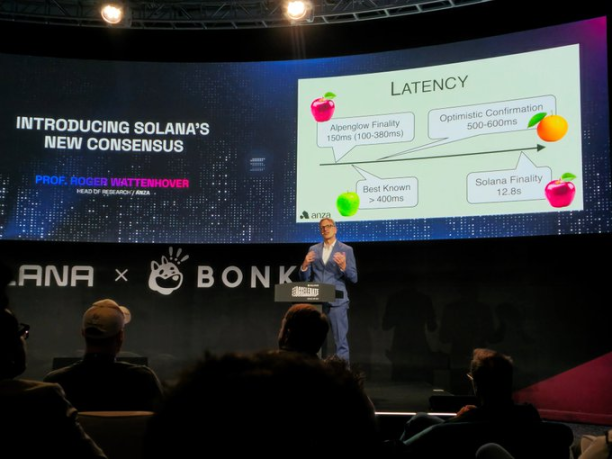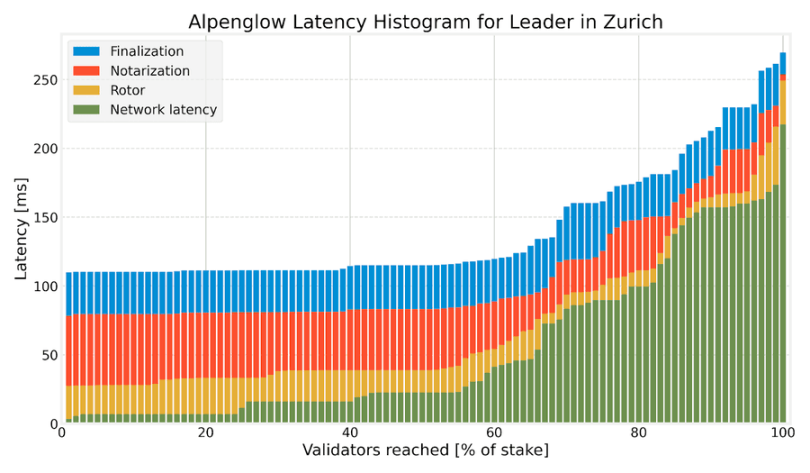Under the new architecture, the efficiency of transaction finality will be improved by 100 times.
Written by: Pzai, Foresight News
On the evening of May 19, Anza, a developer studio previously spun off from Solana Labs, released the new consensus layer protocol Alpenglow for Solana. This protocol modifies the TowerBFT and PoH consensus mechanisms, utilizing a new component called Votor for voting and block finality, while employing the Rotor component to enhance Solana's existing block propagation protocol. It is built on Turbine (Solana's version of sharding) by using single-layer relay nodes and optimizing bandwidth usage based on stake.
Roger Wattenhover, Research Director at Anza, stated at Solana Accelerate that the new consensus mechanism will significantly reduce the current transaction finality duration (12.8s) to 150 ms. In terms of development progress, Alpenglow has completed prototype testing and is expected to deploy a testnet by mid-2025, followed by mainnet deployment later in 2025 after the Solana Improvement Document (SIMD) proposal is approved. Compared to the current Solana mainnet, Alpenglow simplifies the architecture and optimizes data propagation efficiency, making its performance closer to traditional internet infrastructure, suitable for high-frequency trading and real-time payment scenarios. This article provides an overview of Alpenglow, referred to as the "Solana Consensus Reconstruction."

Votor will handle consensus logic and replace TowerBFT. It does not rely on the current nodes' "gossip" model but instead votes on block finality through "direct communication." As a core component of the Alpenglow protocol, Votor's key innovations are reflected in its communication model, voting mechanism, and performance optimization.
First, Votor does not depend on the current nodes' "gossip" model; it adopts peer-to-peer direct communication and dynamic grouping strategies (based on stake weight or geographical location), significantly reducing redundant message transmission and lowering network latency.
Second, Votor introduces a hierarchical stake voting mechanism: if a block receives over 80% support in the first round, it is directly finalized; if the support rate is between 60%-80%, a second round of rapid confirmation is initiated through parallel voting tracks, while allowing nodes to skip voting if they detect block delays or risks, avoiding resource waste. Data shows that when the overall validator threshold is below 60%, latency can be controlled to around 100 ms.

Rotor focuses on improving block propagation efficiency and network resource allocation by integrating Turbine sharding technology, enhancing Solana's existing block propagation protocol. In practice, Rotor replaces the traditional multi-layer relay model with a single-layer relay node architecture, splitting block data into lightweight shards and dynamically optimizing transmission paths, significantly reducing network complexity and transmission latency.
Additionally, Rotor introduces an adaptive propagation algorithm that monitors network status in real-time and switches congested paths, combined with lightweight data verification to reduce computational overhead, greatly enhancing propagation speed and fault tolerance. In terms of performance, Rotor compresses block propagation latency to the millisecond level, supporting Solana in achieving a high throughput target of 50,000 TPS, meeting the demands of high-frequency scenarios such as DeFi settlement and real-time payments.
Overall, the Alpenglow protocol removes the PoH mechanism, reducing operational risks across the entire chain and simplifying the architecture; by utilizing Votor to replace Tower BFT consensus while adopting a stake-driven 1-2 round voting process, it achieves block finality within 100-150 milliseconds without relying on optimistic confirmation; Rotor optimizes Turbine sharding with a single-layer relay system, enhancing propagation efficiency to the physical network latency limit, leaving the primary bottleneck as the underlying network transmission speed. Meanwhile, the system's resilience is significantly enhanced, capable of withstanding extreme scenarios with 20% malicious nodes and 20% staked offline, improving attack resistance and fault tolerance. Ultimately, Alpenglow compresses transaction finality to the millisecond level, providing foundational support for high-frequency trading, real-time payments, and large-scale on-chain applications.
免责声明:本文章仅代表作者个人观点,不代表本平台的立场和观点。本文章仅供信息分享,不构成对任何人的任何投资建议。用户与作者之间的任何争议,与本平台无关。如网页中刊载的文章或图片涉及侵权,请提供相关的权利证明和身份证明发送邮件到support@aicoin.com,本平台相关工作人员将会进行核查。




